Oklahoma, the ‘Sooner State’, is home to a diverse collection of Avian species and is a great state for birdwatching. With 4 mountain ranges and forests that cover almost a quarter of the state, it’s no surprise that our feathered friends feel at home. Today we are going to discuss the backyard birds of Oklahoma and give you a little information about them, as well as some feeder advice and some tips on where you can go around Oklahoma for a sneak peek at some birds you might not have known were living there. Let’s talk about those backyard birds of Oklahoma!
3 Categories – 480 Birds
Oklahoma has a lot of woods and wide-open spaces and as a result, a large bird population. With over 480 species your chances of spotting a new bird are very good in Oklahoma. While we cannot categorize them all, what we CAN do is give you a sampling and we’ll divide the birds up into the seasons when you are most likely to see them. Like this:
- Year-round Resident birds
- Birds of Spring, Summer, and Early Fall
- Fall and Winter Birds
In each seasonal division we’ll have 5 birds and we’ll tell you how to identify them, what they like to eat, and where they ‘hang their hats’ in the wild when they aren’t visiting your backyard. Let’s get started!
Oklahoma’s Year-Round Resident Birds
The birds we have selected in this category are Oklahomans, just like many of you who are reading this article. They love the local geography and have made Oklahoma their year-round home. At any time of the year, see if you can spot one of the following Sooner-state residents:
- Eastern Bluebird
- Carolina Chickadee
- Red-bellied Woodpecker
- Tufted Titmouse
- Northern Cardinal
Eastern Bluebird – Sialia sialis
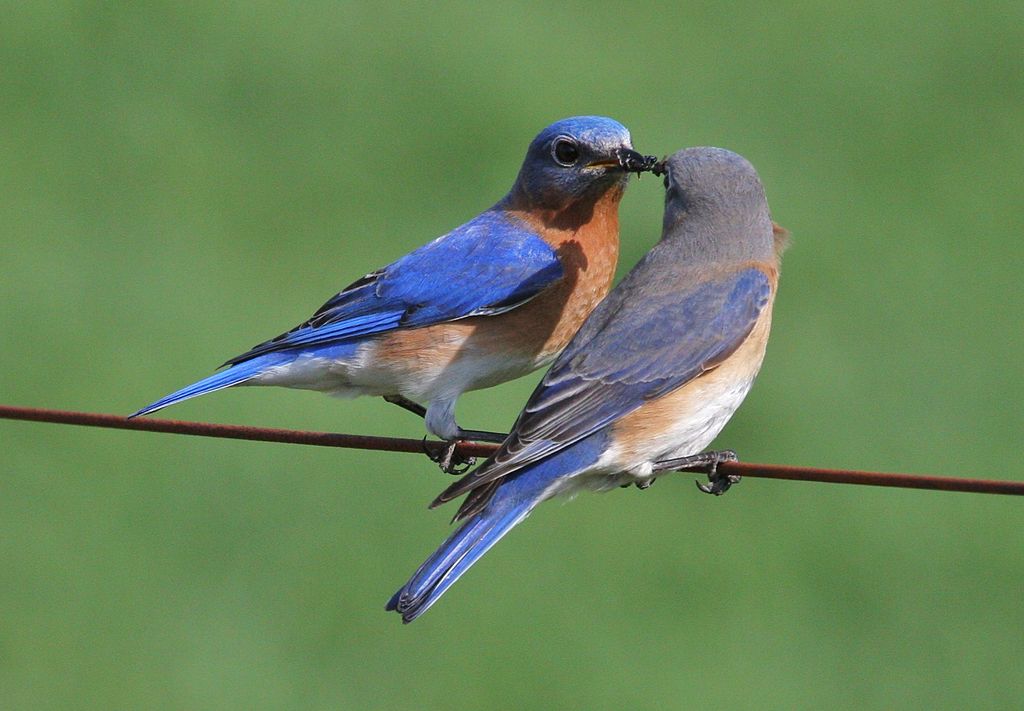
Coloration and Markings: The Eastern Bluebird has a blue back, wings, and a small, blue tail and a rust or darker red breast. The coloration from the breast reaches the sides and also exhibits as a throat band, going to the back of the head. The underbelly is white and facially this birs has a blue face with a meium-length, slightly curved gray bill.
Size: These birds measure in at 6.3 – 8.3 inches in length with wingspans of 9.8 to 12.6 inches.
Habitat: These birds love open meadows and fields and are no strangers to parks, golf courses, and backyard feeders. Leave a little something out for them and you might just get a visit.
Diet: When it comes to feeder-fare, these birds love suet, mealworms, Black Oil Sunflower seeds, and dried or fresh fruit. You can also add crushed eggshells, which is believed to aid in digestion.
Carolina Chickadee – Poecile carolinensis
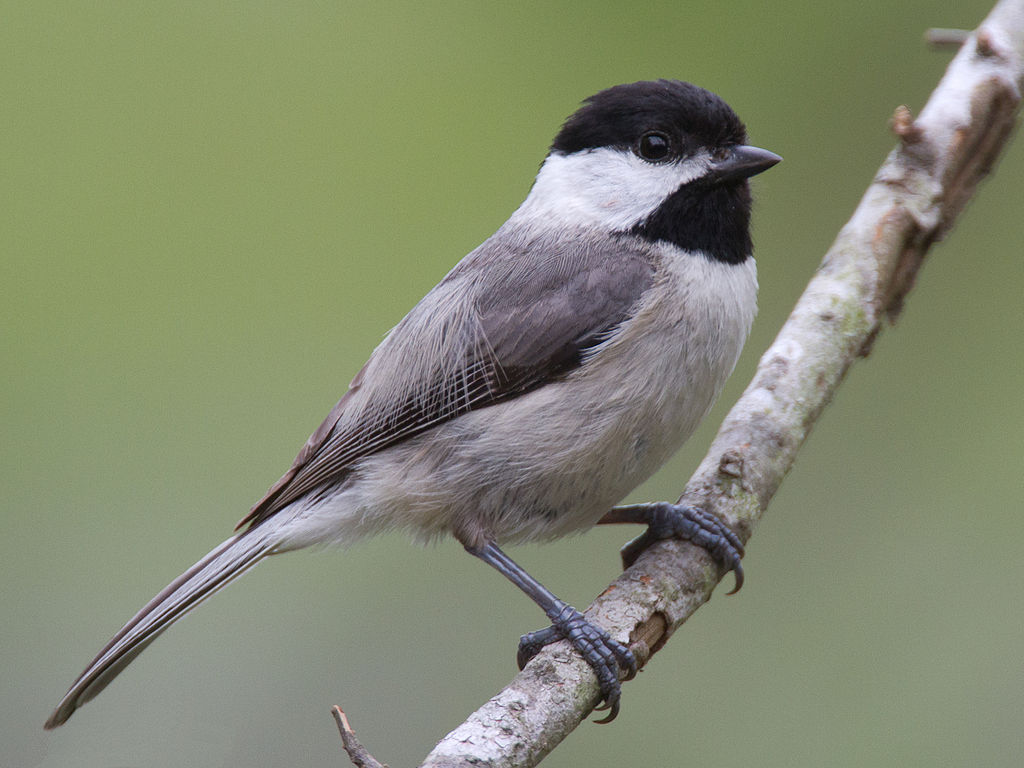
Coloration and Markings: The Carolina Chickadee is a beautiful and easy to recognize bird. They have gray backs, wings, and short, gray fanning tails. Their breast and underbelly is a ‘dirty gray’ mix of gray and white and facially, these birds have a small, black bib from bill to the base of the throat, with a snow-white coloration that starts at the bill, moving across the cheek, to the back of the neck. Above this is a large, black cap with is centered at the middle of the eye. This bird has a tiny, conical black bill.
Size: These little birds measure in at 3.9 – 4.7 inches in length with wingspans of 5.9 to 7.9 inches.
Habitat: These birds love the woods but they will venture forth to visit parks and backyards. Anywhere with some nice, tall trees makes these birds comfortable.
Diet: An easy way to attract these birds is to add some suet and some peanut butter to your feeder. If you have a birdhouse that you want them to use you can also smear one or both of these on the tree trunk where you have the house so that they will investigate and possibly move in!
Red-bellied Woodpecker – Melanerpes carolinus

Coloration and Markings: Beautiful and instantly recognizable, the Red-bellied Woodpecker has black and white stripes, rather like a zebra. These are seen on the back, wings, and on its medium-sized tail. When this bird is in flight, tell-tale white patches may also be seen at the wingtips. The breast and underbelly of this bird are white with light tinges of red and this coloration goes all the way up to the center point of the eyes on this bird. There is a distinct red cap at the top of the bird’s head, going down to the level of the wings, and this bird has a long, straight black bill.
Size: These birds measure in at approximately 9.4 inches from tip to tail with wingspans of 13 to 16.5 inches.
Habitat: These birds may be found in the woods anywhere there are hardwood trees growing, such as hickory, oak, or maple. They aren’t shy about visiting parks or backyards, so be sure to keep your feeder stocked just in case!
Diet: These birds will eat many things but for best results, try adding suet, Black Oil Sunflower seeds, and peanuts to your feeder as these are all favorites of the Red-bellied Woodpecker.
Tufted Titmouse – Baeolophus bicolor
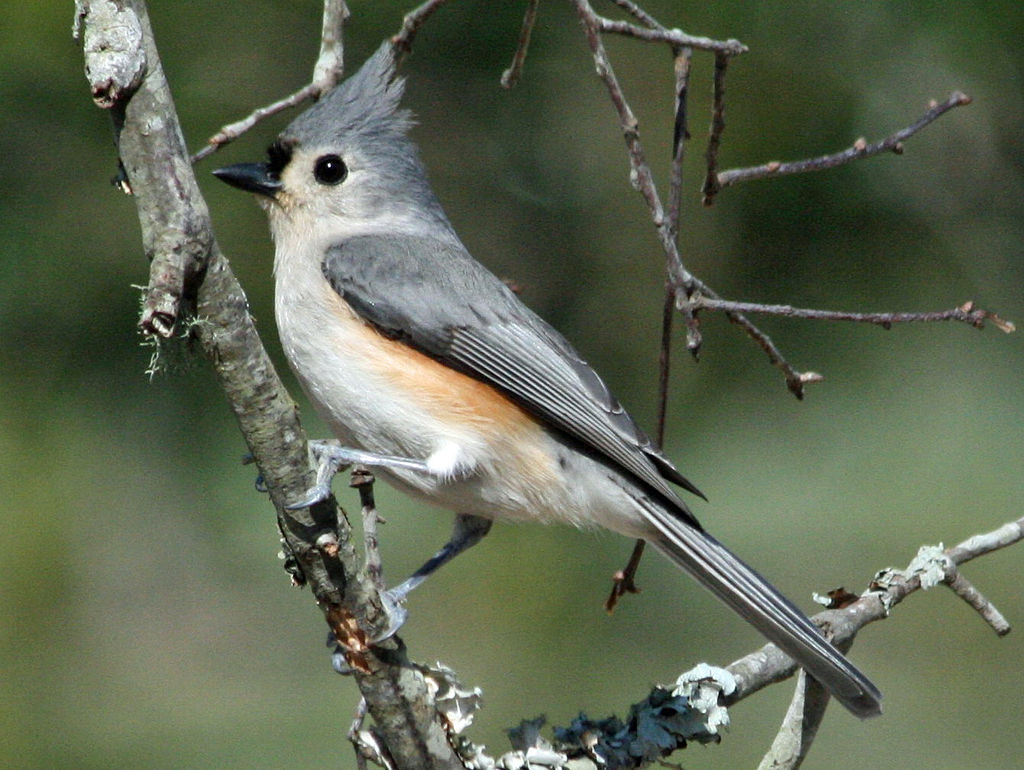
Coloration and Markings: The Tufted Titmouse has beautiful blue-gray backs, wings, and a long blue-gray tail. They have a white breast and underbelly, with peach coloration on their sides just under the wings, and facially these birds have a lovely little blue crest that carrys color down the sideof the face, just shy of the neck, down to cheek level. The remainder of the face is white with the exception of a distinctive black square mark above the small, slightly curved bill.
Size: These birds measure in at 5.5 – 6.3 inches in length with wingspans of 7.9 to 10.2 inches.
Habitat: Evergreen and deciduous forests are favorite haunts of these birds when they are out in the wild. They also love orchards, home gardens, parks, and backyards. These birds are more than happy to visit your feeder!
Diet: Suet, Black Oil Sunflower seeds, and peanuts are a triple-threat combination that will keep a Tufted Titmouse’s attention and keep them coming back for more. Give it a try and see.
Northern Cardinal – Cardinalis cardinalis
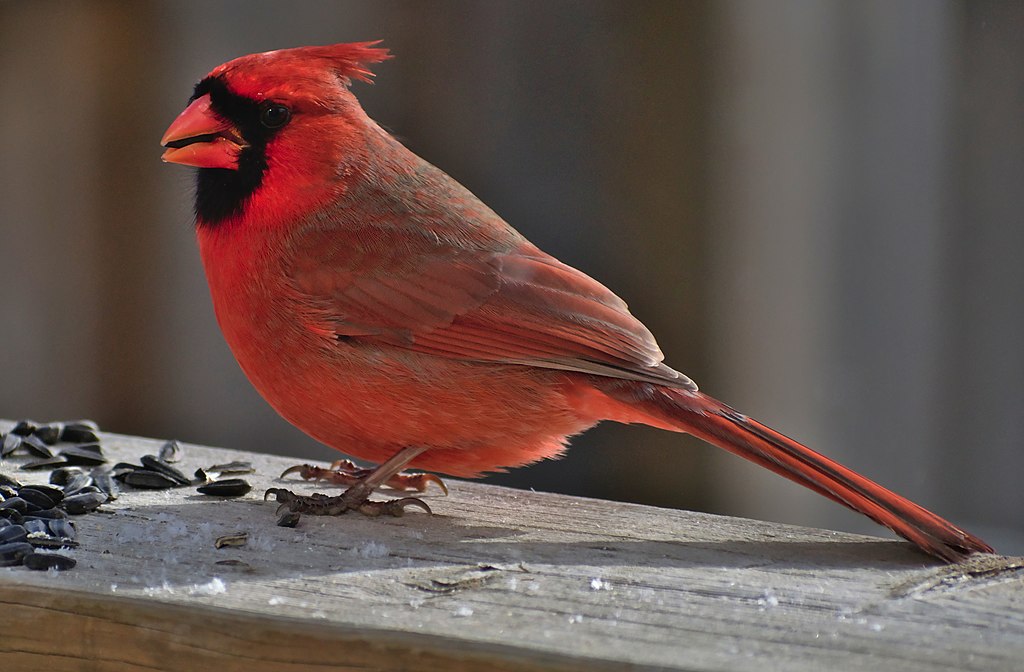
Coloration and Markings: Male Cardinals are striking and as such they are harder to miss than they are to spot. Cardinals have a rich red coloration all over their bodies, though you might occasionally see some gray in their wings or at their long, rounded tails. Facially, this bird has a beautiful mask that crosses the eyes and sharply crossed the chin beneath it’s stout, conical orange bill. They have beautiful crests to top off their look smartly and while the females get a different coloration, theirs is quite nice, too. Female Cardinals will be brown, with reddish tinges all over, and the same distinct orange bill. It is not as flashy but it is still very lovely plumage and you’ll enjoy seeing it up close.
Size: These birds measure in at 8.3 – 9.1 inches in length with wingspans on average of 9.8 to 12.2 inches.
Habitat: Northern Cardinals love to inhabit the same areas that we do. You’ll find these urbanized birds hanging out in parks, scouting from telephone wires, and spending time in backyards. When they do go to the woods it will typically be at the edges, rather than deep inside, but the majority of them are going to be in the town or city proper.
Diet: These birds have varied diets, with White Proso millet and Black Oil Sunflower seeds being 2 of their favorites. They also like cracked corn, crushed peanuts, and fresh or dried assorted berries.
Oklahoma’s Birds of Spring, Summer, and Early Fall
Oklahoma springs are a pleasure, with warm winds and the rains making everything green again. The summers, though, can be a little hardcore and they make you happy when fall comes in. The birds that we’ve picked out for this category are happy in any of these 3 seasons and they’ll prove it by spending them in your backyard, if you know what to leave out. See if you can tempt one or more of the following into your backyard:
- Scissor-tailed Flycatcher
- Eurasian Collared-Dove
- Painted Bunting
- Barn Swallow
- Carolina Wren
Scissor-tailed Flycatcher – Tyrannus forficatus

Coloration and Markings: The Scissor-tailed flycatcher is quite the sight. They have gray backs, which pinken up a bit at the shoulders and display reddish-brown shoulder patches. Their wings are a pretty white-edged black but their tails are the most noticeable. These black, white-edged tails are very long, about 3 times what you would expect to see on a bird this size, and the name is earned because the bird seperates the tail in two when it flies to create the ‘scissor’ effect. They have a white breast and underbelly with a heavy flanking of creamy salmon coloration and facially, these birds have some gray skin showing in front of the eye with the rest of the face being mostly white. The exception is that the back of the head and neck are often a very light gray that compliments the white. These birds have medium-length, straight black bills.
Size: These birds measure in at 8.7 – 14.6 inches in length with wingspans of approximately 15 inches.
Habitat: These birds love open areas, where they can fly and catch insects comfortably. Any open areas with tall trees will attract them and they are also comfortable in towns and cities, where they typically alight on telephone wires and look for snacks.
Diet: While these birds make up most of their diets with insects ‘caught on the fly’, they do supplement their diets with small fruits. Small chopped or whole berries, such as strawberry or cherry, may tempt the Scissor-tailed Flycatcher to your feeder. Fruiting trees, bushes, or vines will greatly increase your chances as well.
Eurasian Collared-Dove – Streptopelia decaocto
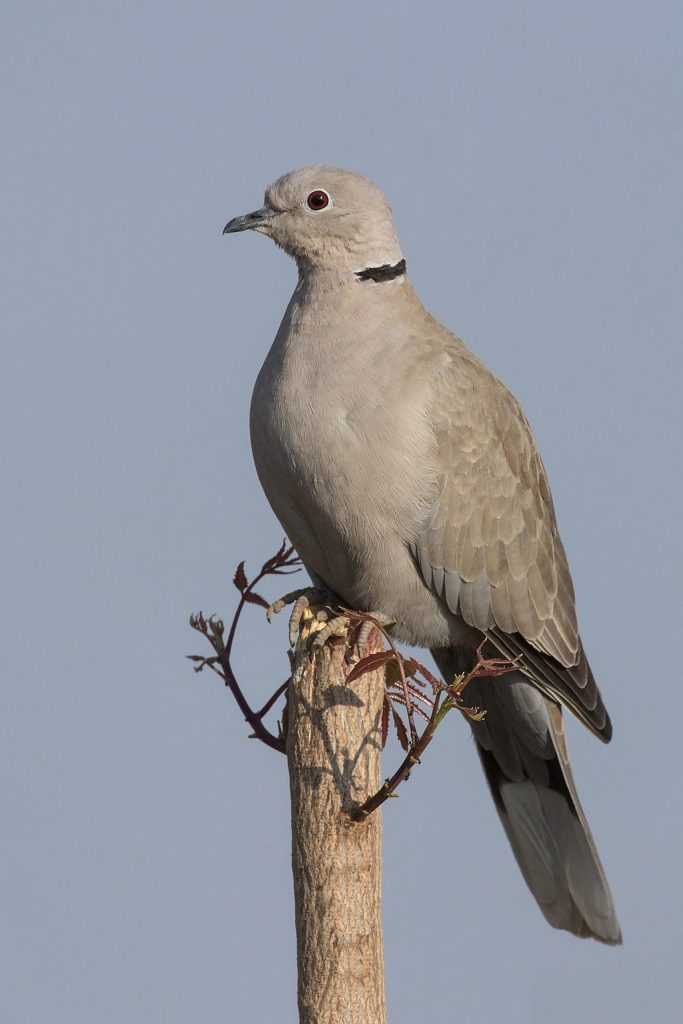
Coloration and Markings: The Eurasian Collared-Dove is typically brown or gray and tan on it’s back, wings, and it’s long, gray tail. One exception, however, is that the wingtips will typically be darker, generally a dark gray or even black. The breast and underbelly will have similar, if somewhat softer coloration, and looking up you will notice a distinct black crescent collar-mark is present on this Dove’s long neck. Facially, this bird is mostly white, often with a black line from the bill to the front of the eye and with some gray at the back of the head. This bird has a medium-sized, slightly curved black bill.
Size: These birds measure in at 11.4 – 11.8 inches in length with wingspans of approximately 13. 8 inches.
Habitat: Cities and farms are where these birds like to spend their time, eschewing the woods for the ‘easy picking’ food of inhabited areas.If you see them in the woods it will only be at the forest’s edge.
Diet: Seeds and grains are what the Eurasian Collared-Dove craves, so stock up on White Pro millet, Black Oil Sunflower seeds, wheat, oats, and cracked corn.
Painted Bunting – Passerina ciris

Coloration and Markings: A prized sighting, Painted Buntings have yellow-green backs and wings, with the wings showing some dark gray highlighting and the wingtips darkening to black. The lower-back is reddish orange and it has a long gray tail while the breast and underbelly are a rich orange-red. This red color goes all the way up to the bill, with some blue flanking lines at the shoulder. If you follow the blue lines with your eyes they move up to fill thes rest of the face with a deep blue coloration. You will notice a distinct eyering, often red, and this bird has a shorty, curved gray bill. Females and juveniles will not have any markings other than a dim eyering and they will be yellow-green all over their bodies.
Size: These little beauties measure in at 4.7 – 5.1 inches in length with wingspans of 8 to 8.5 inches.
Habitat: At the edge of the woods or deep in brush, bramble, or thickets these birds are most often found. Fields are familiar haunts for them as well, provided that they are overgrown to provide a little cover.
Diet: White Proso Millet and Black Oil Sunflower seeds will make Painted Buntings very happy but we recommend that you utilize a protective cage around the feeding tube to discourage larger birds from scaring them off. These are shy birds so they need the extra security.
Barn Swallow – Hirundo rustica
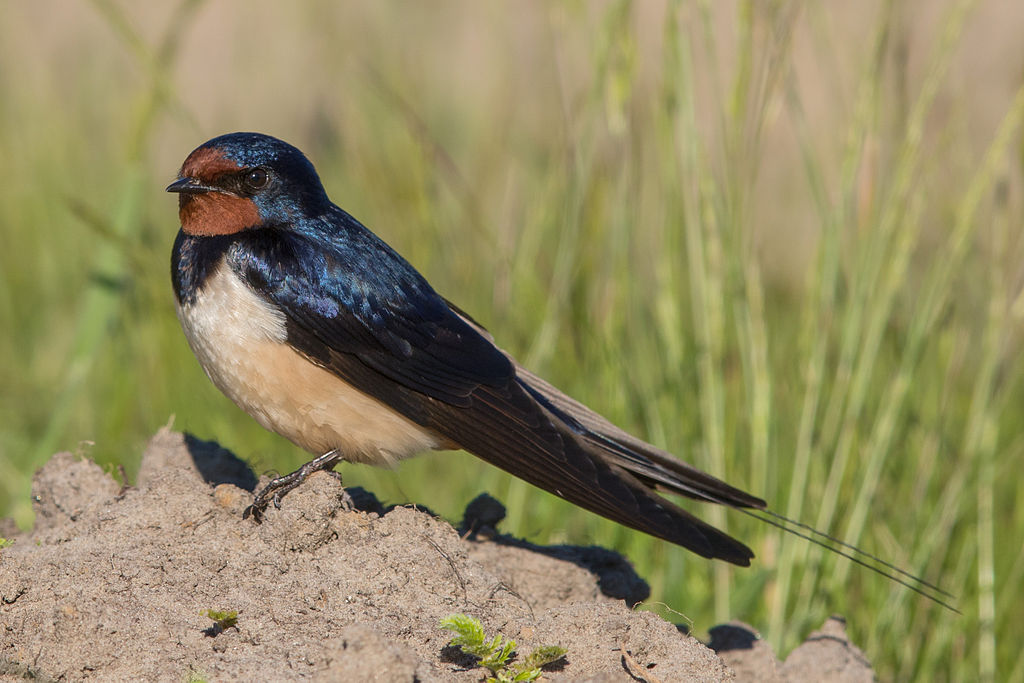
Coloration and Markings: Barn Swallows are easy to recognize once you’ve seen one and your first sighting will definitely be exciting. These birds have beautiful coloration, with deep blue backs, wings, and forked-blue tails with a little white edging to accent them. White spots may sometimes be seen under the wing and there are small white markings at shoulder level and under the wings of this bird as well. The blue from the back and shoulders extends over into the breast on both sides in the form of broad lines, giving this bird the appearance of wearing a cape. The breast and underbelly of this bird are a soft orange-brown that deepens in color as it moves up the face. Facially, the red that you see outlines the cheeks and ‘triangulates’ at the bill, stopping just over it, with the rest of the face being deep blue with the exception of a diamond-shaped black mask. These birds have short, straight black bills. Females have the same coloration but the colors are slightly muted.
Size: These birds measure in at 5.9 – 7.5 inches from head to tail with wingspans of 11.4 to 12.6 inches.
Habitat: As the name suggests, these birds will nest in barns and other buildings, and they prefer open areas such as fields, parks, and meadows. They are attracted to water as well so you might see one foraging at the edge of a pond or in marshes.
Diet: These birds like to catch live food, but will sometimes eat berries to supplement their diets (especially in winter). Try loading up the feeder with some dried mealworms and crickets, dried or fresh berries, and eggshells. Like many birds, they will eat eggshells and this is believed to help with digestion.
Carolina Wren – Thryothorus ludovicianus

Coloration and Markings: The Carolina Wren may be identified by it’s cinnamon back, wings, and tail. Look for small black and white ‘cubes’ that form the edging on this birds wings and tail combined with its yellow-orange breast and underbelly. Facially, this bird has brown coloration on the upper portion of the face, while the throat and the lower part of the face is white. You will also see some black-dotted gray under the eye which extends down to the cheek. Above the eye is a long white eyebrow mark and this bird has a long, slightly curved black bill.
Size: These diminutive birds measure in at 4.7 – 5.5 inches in length with wingspans of approximately 11.4 inches.
Habitat: These are brush and bramble birds, for the most part. While you might hear them singing from a treetop you will more likely hear them from thickets, where they like to forage in relative safety.
Diet: Primarily insectivorous, these birds sometimes supplement their diet with seeds and berries. Try some chopped cherries or strawberries and leave out some White Proso millet mixed with small Black Oil Sunflower seeds for best results. If you have some bushes in your yard then this is a plus for attracting the Carolina Wren.
Oklahoma’s Fall and Winter Birds
Oklahoma is home to robust summers and some chilly winters, with average around 30 degrees Fahrenheit but on rare occasions can drop as low as 17 degrees. Brr! These birds are undaunted by this and are waiting to entertain you on thos chilly months. Keep your eyes peeled for these Oklahoma winter birds:
- Dark-eyed Junco
- American Goldfinch
- Mourning Dove
- Red-winged Blackbird
- Rusty Blackbird
Dark-eyed Junco – Junco hyemalis

Coloration and Markings: Dark-eyed Juncos can have some varying coloration depending on the region, however, in general you can look for a bird with gray back, wings, and long gray tail with white in the center of the breast heavily flanked by gray and a white underbelly that extends it color to the to the outer tailfeathers. Facially, the gray deepens and this bird has a short, stout conical pink bill. The easiest way to recognize this bird is to look for a bird that is 2/3 gray from the top going down and white on the remaining lower portions.
Size: These birds measure in at 5.5 – 6.3 inches in length with a wingspan of 7.1 to 9.8 inches.
Habitat: These birds favor coniferous forests and large, open areas, such as weedy fields, parks, and backyards.
Diet: Insects and seeds are what this bird eats, so stock up the feeder with some dried mealworms and crickets with a side of Black Oil Sunflower seeds and maybe some White Proso millet for good measure.
American Goldfinch – Spinus tristis

Coloration and Markings: Delightful and easy to recognize, the American Finch has a bright yellow back with black wings, displaying some white at the shoulder level, followed by a wingbar on each wing, and vertical white lines lower on the wing. They havelong, black tails with white markings as well and the breast and underbelly of this bird provide contrast with their bright yellow color. At the rump of this bird you will see some white coloration and facially, they have yellow faces with a black cap starting from the top-middle of the head straight down to the short, conical orange bill. Females have dimmer yellows and olive coloration in place of the black and in the winter both genders molt their bright plumage in lieu of dull brown feathers. The distinctive wingbar is still present, but dim, so if you look carefully you’ll find that they are still easy to identify.
Size: These little birds measure in at 4.3 – 5.1 inches in length and have wingspans of approximately 7.5 to 8.7 inches.
Habitat: Areas prone to flooding and wide, open weedy fields are favorite places for this bird to forage.
Diet: Black Oil Sunflower seeds mixed with Nyjer thistle will get and keep the attentions of an American Finch.
Mourning Dove – Zenaida macroura
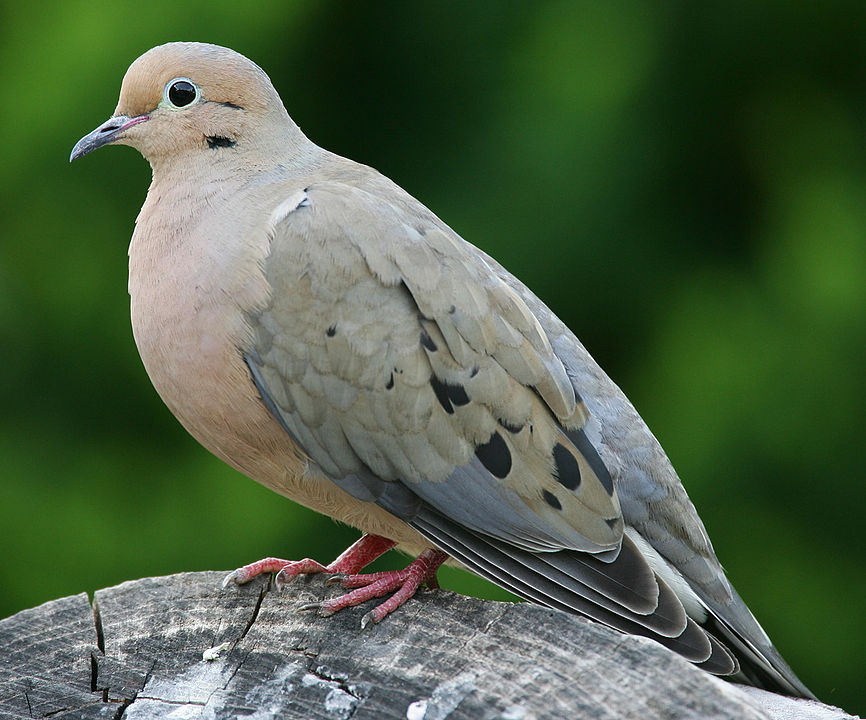
Coloration and Markings: Mourning Doves are plump and pretty, with gray backs and wings with the wings showing concentrations of a creamy tan color as well as distinctive black spots towards the rump. They have long, gray tails and a tan breast and underbelly, with some gray flanking on the sides of the underbelly. Facially, these birds have the deepest concentration of tan, as well as a distinctive white eyering in front of a short, straight bill.
Size: These birds measure in at 9.1 – 13.4 inches and have wingspans of approximately 17.7 inches.
Habitat: Largely urbanized, these birds prefer to stay out of the deep woods although you might see them at the edges. More commonly you’ll find them in open areas such as fields, farms, or in town watching from the telephone wires or even walking on the sidewalk.
Diet: Mourning Doves love seeds and grains, so go with some White Proso Millet, cracked corn, oats, wheat, and Black Oil Sunflower seeds. Any one of these or a few in combination will get their attention and keep them coming back for more.
Red-winged Blackbird – Agelaius phoeniceus

Coloration and Markings: Red-winged Blackbirds are quite easy to recognize. They are completely black all-over with the exception of their shoulder markings, which consist of a large red or orange-red spot with a yellow spot underneath. When the bird is at rest, the red spot looks almost fin-shaped and the horizontal line of the yellow gives it a look like seeing a shark fin in yellow waters. Facially, they have long, conical black bills.
Size: These birds measure in at 6.7 – 9.1 inches in length with wingspans of 12.2 to 15.8 inches.
Habitat: While you might spot them in an overgrown field or a grassy meadow, these birds prefer areas with water. They are more commonly seen next to ponds of in marshes as they forage for their meals.
Diet: These birds love just about any seed and grain combination. Mix up some wheat or White Proso millet with some Black Oil Sunflower seeds and you’ve got a simple treat that these birds will love.
Rusty Blackbird – Euphagus carolinus

Coloration and Markings: The Rusty Blackbird gets its name from the way it looks in the wintertime. During the warm months it is hard to identify, being completely black all over with yellow eyes and a long, straight black bill. In winter, however, the plumage takes on a number of rust-red feathers that allow for proper identification. You will also notice a tan eyebrow whilte the females will have darker plumage around the eyes and more of a gray-brown overall look, with a scattering of rust-feathers that confirm its identity.
Size: This bird measures 8.3 – 9.8 inches from head to tail and has a wingspan of approximately 14.6 inches.
Habitat: These birds love to forage near water, so you will typicqlly spot them in bogs, marshes, or near ponds and streams.
Diet: These birds are hard to attract to feeders, as they mostly eat insects, but as they will occasionally eat seeds as well you might have some luck with Black Oil Sunflower. Scatter some of the seeds at the base of the feeder as well for good measure.
Supporting cast (Other Backyard Birds of Oklahoma That Might Pay You a Visit)
While these birds don’t get that fancy space at the beginning of the article, they are stars nonetheless and a pleasure to spot. So be sure to take a gander at this list and load your feeder accordingly to show appreciation for the ‘Supporting Cast’. These little guys are available year-round in the lovely state of Oklahoma and they can’t wait to meet you! Without further ado, let’s meet the birds:
- Downy Woodpecker
- American Robin
- Northern Mockingbird
- Blue Jay
- House Sparrow
Downy Woodpecker – Picoides pubescens
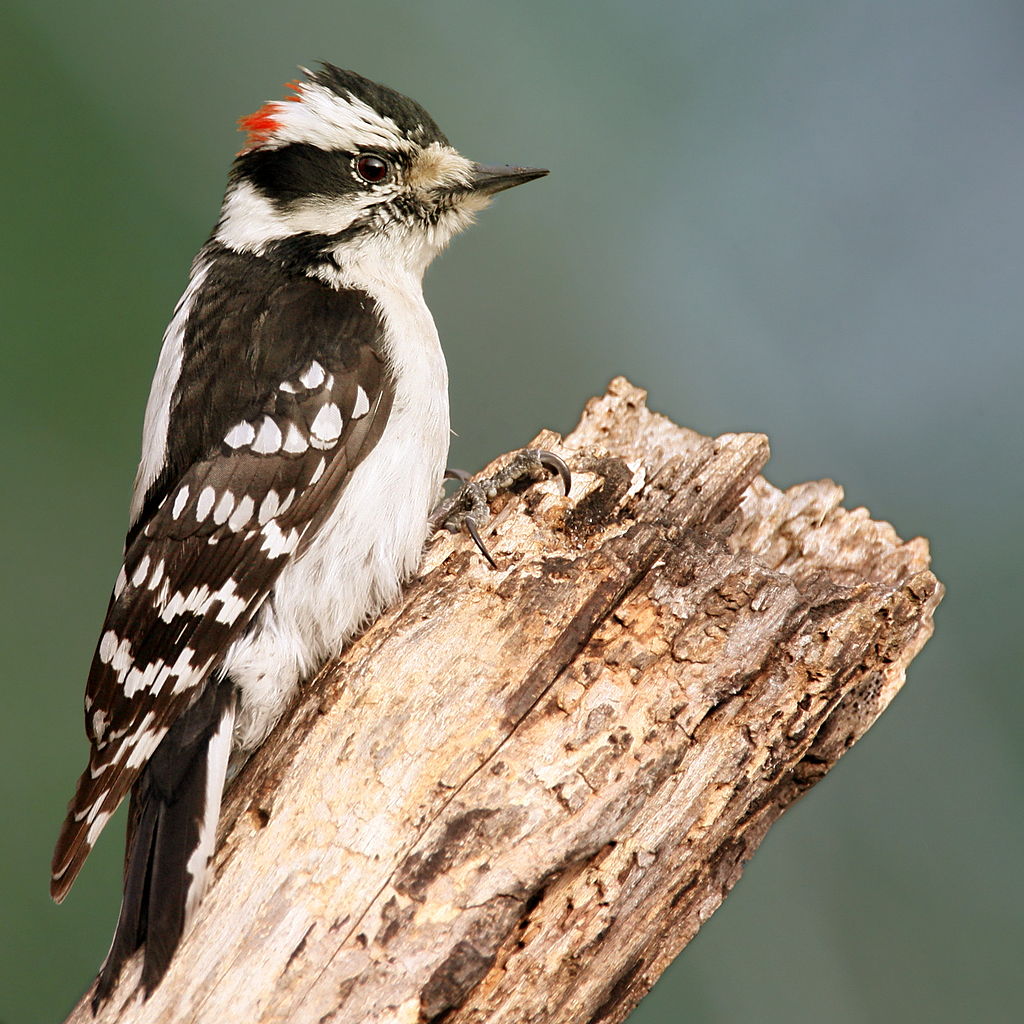
Coloration and Markings: Downy Woodpeckers are small Woodpeckers with lovely plumage that is instantly recognizable. They have white backs and black tails which are white underneath, as well as black wings. These wings have zwavy lines made up of small white blocks going across them, starting just below shoulder level, that give the wings a ‘checkered’ look. The breast and underbelly of this bird are paper-white and this coloration continues up to the throat and head. Facially, aside from the white, this bird has a black mustaches line as well as a fine black mask which goes all the way to the back of the head. There is also a black cap at the top of the head which, in males, terminates at a red mark at the back of the head. Females will have the cap but not the red and these birds have medium-sized, straight black bills.
Size: Relatively small for Woodpeckers, these birds measure in at 5.5 – 6.7 inches in length with wingspans of 9.8 to 11.8 inches.
Habitat: Downy Woodpeckers like deciduous woods where there are wide, open spaces to survey. You can also find them around weedy fields, parks, and backyards.
Diet: These little guys like suet, Black Oil Sunflower seeds, and White Proso millet. They’ve got a sweet tooth, however, and may also sample Hummingbird feeders and are especially fond of chunky peanut butter. Try putting some out and see what happens!
American Robin – Turdus migratorius
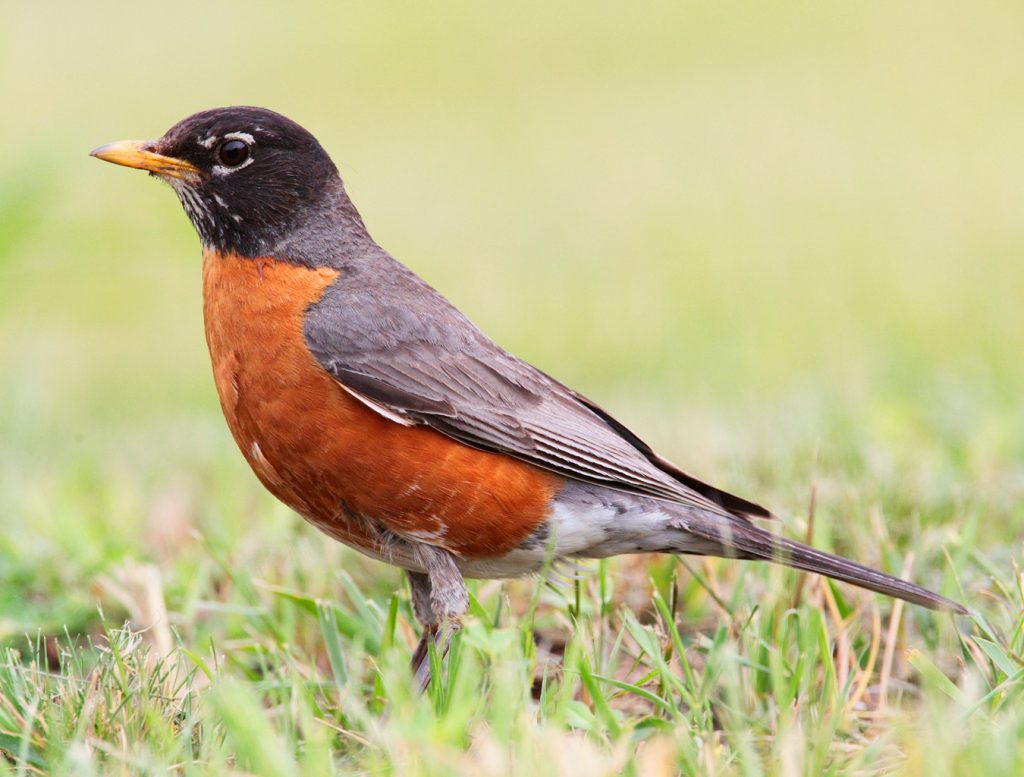
Coloration and Markings: American Robins are gray and brown on the back, wings, and tail, with white on the underside of the tail originating from the bird’s rump. The breast and underbelly are a dark Tangerine orange color and facially, this bird has a gray and brown or black head with white eyering fragments being visible in front of a small, curved yellow bill.
Size: These birds measure in at 7.9 – 11 inches in length with a wingspan of 12.2 to 15.8 inches.
Habitat: American Robins may be found in a number of different places. You might see one foraging in the snow, exploring fields, or even scoping out shrubs. They like Evergreen and deciduous forests but venture into suburban areas frequently and will most certainly be happy to visit a stocked backyard feeder.
Diet: These birds like a lot of different foods. You can feed them mealworms, dried crickets, or suet for a little protein but they are also fond of raisins, crushed peanuts, and Black Oil Sunflower seeds on the side. A little bit of everything will most likely spoil them into becoming a regular visitor, so give it a try if you want to lure one of these birds to your feeder. These foods get results.
Northern Mockingbird – Mimus polyglottos

Coloration and Markings: Northern Mockingbirds have brown and gray backs, wings, and long, perky tails, with two white wingbars present on each wing. In flight these wingbars turn into spectacular white patches and these birds have a white breast and a ‘dirty white’ underbelly. Facially, these birds have a dirty-white color from the bill to throat, often with a gray line coming from the back of the eye and circling down across the throat. Behind this line and on the upper portions of the head this bird is gray and a black line is often seen from its short, slightly curved black bill to the front of the birds eye.
Size: Roughly Robin-sized, these birds measure in at 8.3 – 10.2 inches in length with wingspans of approximately 12.2 to 13.8 inches.
Habitat: You can find Northern Mockingbirds at the forest’s edge, in parks, or scattered around the suburbs. These birds are not shy about visiting backyard feeders so be sure to leave a little something out for them.
Diet: You can occasionally lure these birds to your feeder with suet and chopped up apples or oranges.
Blue Jay – Cyanocitta cristata
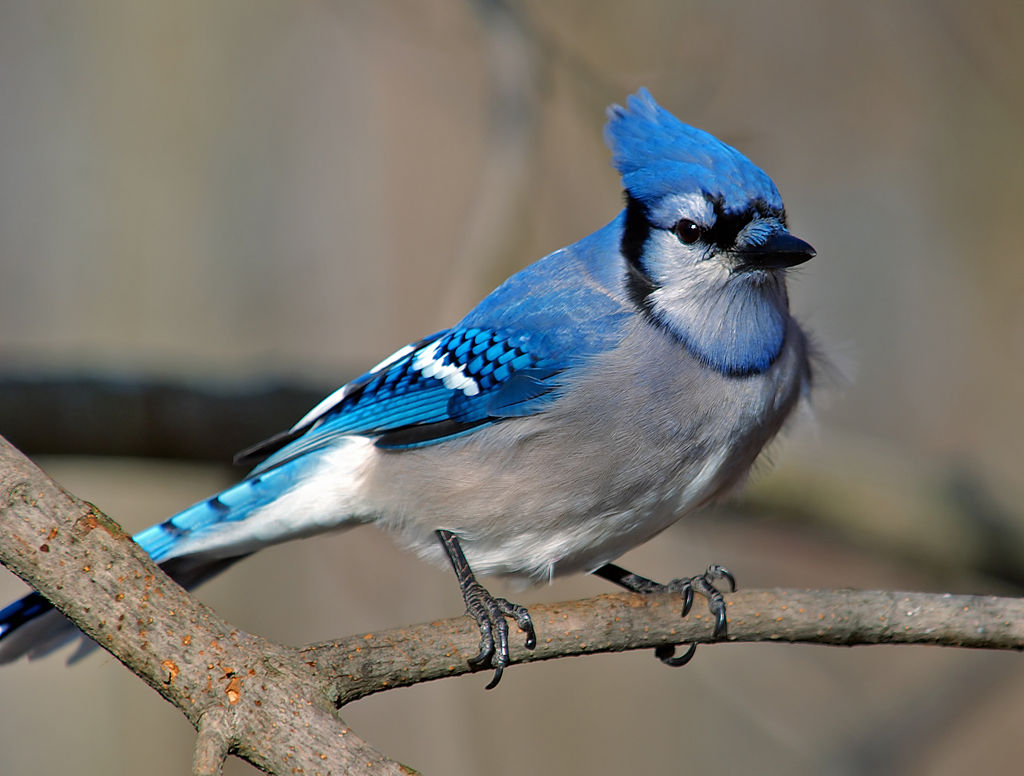
Coloration and Markings: Blue Jays are stunning and easy to recognize. They have solid blue backs that show a ‘scaling’ patter of blue outlined in black starting just above the white wingbar on each wing and as the coloration descends towards the tail you see larger white spots outlined in black. The tail is symmetrically segmented patterns of lighter blue outlined in black or dark blue and it is white on the underside. The breast and underbelly of this bird are snowy-white and facially, this bird has a black line that travels from the back of the bird’s lovely crest and circles the throat to the other side. This bird has a white face with a thin black mask that connects to the line at the back of the head and zigzags a bit, giving it an ‘abstract’ look. This bird has a long, straight black bill.
Size: These birds measure in at 9.8 – 11.8 inches in length from tip to tail and have wingspans of approximately 13.4 to 16.9 inches.
Habitat: These birds are fond of spending their time at the forest’s edge and are also quite fond of Oak trees and their delicious acorns. Unafraid of people, Blue Jays spend a lot of time in the city as well and will gladly visit your feeder for some well-chosen snacks.
Diet: Blue Jays will eat a lot of things but some of their favorites are Black Oil Sunflower seeds, peanuts, and suet.
House Sparrow – Passer domesticus

Coloration and Markings: The male House Sparrow has a rich brown color on its back, wings, and its short tail. Black accenting colors are present on the wings and tail and the breast of this bird is a dirty gray with some scattered black from the bird’s bib in the middle. The underbelly is a darker gray and facially, the black bib thins out, going straight up to the bill as a thick black line. The bottom half of the face is white, in a shape that goes all the way across the base of the neck to the bib and that carries up to highlight the cheeks, terminating just under the eye. At eye level, this bird has a mask which starts as a black line from the bill to the front of the eye, where is becomes rich brown and curves down to just above the base of the neck to elegantly frame the cheek. The top of this bird’s head is a wide, gray stripe and it has a short, stout, and slightly curved black bill.
Size: These birds measure in at 5.9 – 6.7 inches from tip to tail and have wingspans of approximately 7.5 to 9.8 inches.
Habitat: These are city birds and if they want to get closer to nature they’d rather visit the Zoo to steal some snacks rather than spend time in the woods. Aside from zoos, you can find them in parks or perched on telephone wires in your town or city as they look for their next meal. They will be more than happy to visit your backyard if you’ve left some treats out.
Diet: Black Oil Sunflower seeds, White Proso millet, and cracked corn are 3 favorite items of the House Sparrow that you can use to tempt them and hopefully to keep their attentions.
Oklahoma Bird Buffet
The Oklahoma Department of Wildlife Conservation’s Wildlife Diversity Program has some advice for stocking up your feeder to attract the most birds in Oklahoma for a backyard visit. We’ll include some highlights here as well as some of our own suggestions for making your feeder irresistible! Be sure that you add one of more of the following:
- Black Oil Sunflower
- Suet
- Sugar water
- Peanuts
- Dried mealworms
- Dried crickets
Oklahoma Birding Hot spots
The Chirparazzi get around, searching the world for the best-kept secrets of birdwatching hotspots where they may take photos of Natures aerial celebrities. Today they’d like to share a few places where you can go to see the stars yourself the next time that you feel like getting out of the house for a little exercise of the birdwatching kind. The locations listed are centered around the compass points for your convenience and a central location is included as well. Should none of these be close to you, just take advantage of the link you’ll see below this list and you can find something that is a better fit for you. Be sure to visit one or more of these locations when you have a little time to kill:
- Northern hotspot – Pathfinder Parkway
- Eastern hotspot – Old Frisco Trail
- Southern hotspot – Chickasaw National Recreation Area
- Western hotspot – Washita National Wildlife Refuge
- Central hotspot – Legacy Trail
Detailed descriptions of each location as well as information regarding visiting and what birds you can see at these locations may be found at https://www.traillink.com/stateactivity/ok-birding-trails/
Final Thoughts
That’s about all the time that we have for today but we hope that you’ve enjoyed this taste of the kind of birding experience that Oklahoma provides. Keep in mind that with 480+ species, what we have shown you is just a drop in the bucket. If you’d like to learn more be sure to explore the reference links which we have provided for your pleasure and be sure to update your birding checklist… because when it comes to birdwatching, Oklahoma is going to keep you very, very busy. Happy birding, folks!
